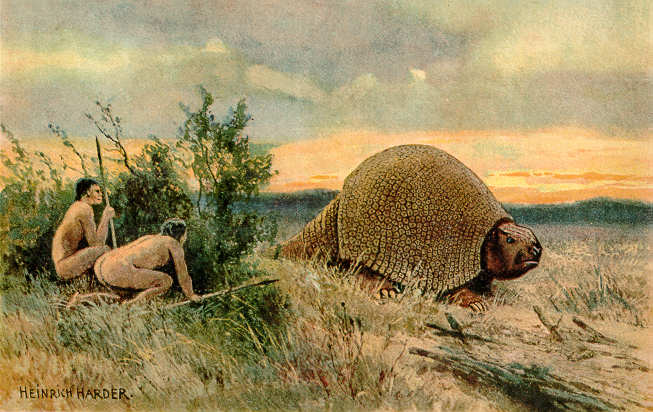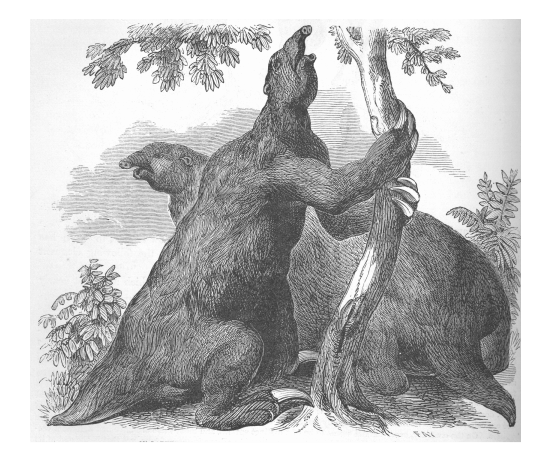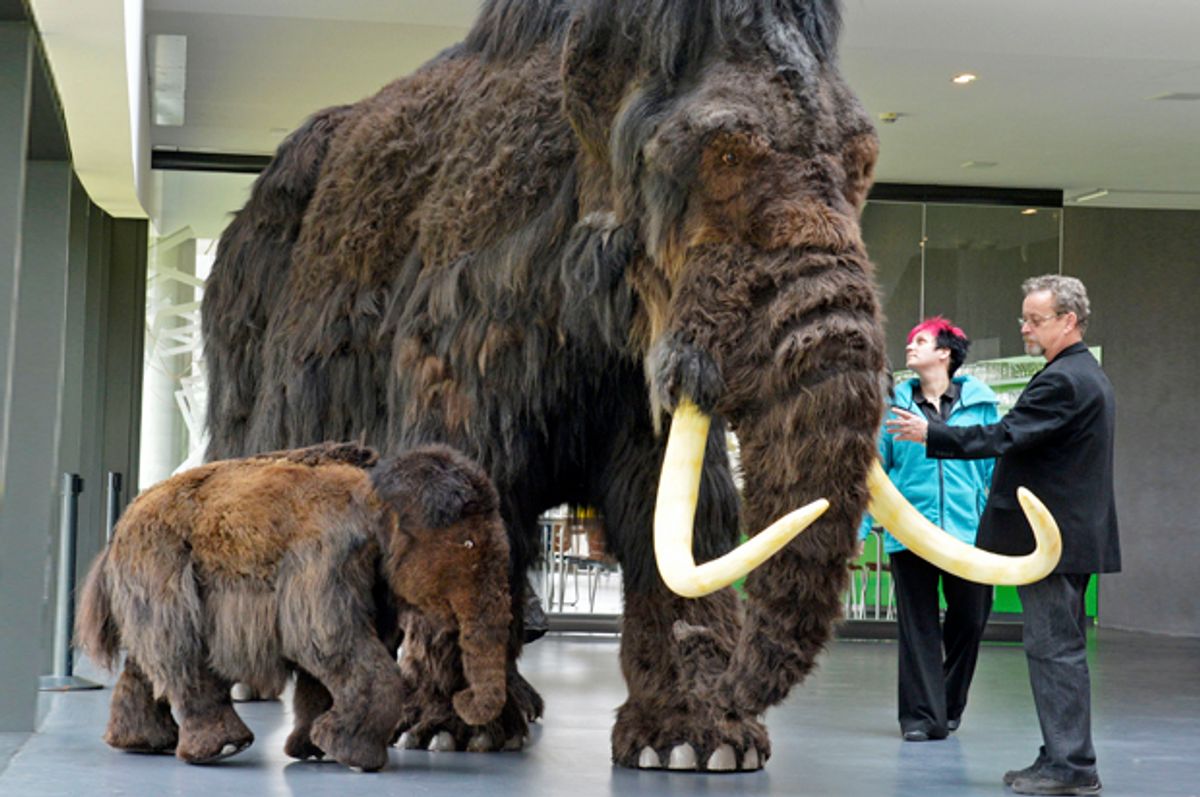Beginning 80,00 years ago, many of prehistory's most famous large animals, including mammoths, wooly rhinos and sabertooth tigers, began to vanish from the Earth. We've never been able to say why -- until now. That's the claim of a new study published this week in the journal Ecography by researchers from the universities of Exeter and Cambridge, who have used innovative statistical analysis to identify the real culprit. Bad news: Humans did it.
The study's authors say that they have decisively settled a long-running debate about whether these extinctions were caused by humans or climate change, or even some combination of the two. They ran thousands of scenarios that showed that, even accounting for changes in climate, none of the megafauna went extinct until humans showed up. "As far as we are concerned, this research is the nail in the coffin of this 50-year debate - humans were the dominant cause of the extinction of megafauna," Lewis Bartlett, the study's lead author, told Phys.org. "What we don't know is what it was about these early settlers that caused this demise. Were they killing them for food, was it early use of fire or were they driven out of their habitats? Our analysis doesn't differentiate, but we can say that it was caused by human activity more than by climate change. It debunks the myth of early humans living in harmony with nature."
Such myths have never been very strong. Since the 18th century, when explorers and scientists began discovering the bones of these animals and realizing what they were, the popular imagination has pictured our ancestors cowering before strange and terrible beasts, only overcoming them through desperate struggle or cunning. It is only in recent decades that have we come to realize that the slaughter of the megafauna never ended, and we're still driving lions, rhinos, bears and whales to extinction. Now we seek to protect these animals and many feel outrage when they are killed. Even more radically, some of these long-dead animals may be brought back to life by efforts such as the Long Now Foundation and Pleistocene Park. One day we might again see Wooly Mammoths roaming the steppes of Siberia.
Many extinct megafauna are well known, but many remain totally mysterious. Little is known beyond legend of Sylviornis, a kind of giant chicken that once lived on New Caledonia. Some are almost theoretical, such as the Giant Polar Bear, known only from a single bone found under a bridge in London. Here are some of the fascinating megafauna that we probably once hunted to extinction.
The Glyptodon

Glyptodon, by Heinrich Harder 1916. Public domain.
This large, heavily armored relative of the armadillo once roamed the lowlands of South America and reached as far as modern-day Guatemala. Lumbering and herbivorous, it had little defense against the early human settlers, who may have used its thick, domed shell for shelter. Glyptodon was an early megafauna celebrity, discovered by pioneering English biologist Richard Owen, the man who coined the name "Dinosaur". The London Literary Gazette reported its discovery in breathless wonder,
A still more interesting discovery is that of the apparently complete remains of another monstrous fossil animal, completely unknown to us, of which I annex a sketch reduced by Mr. Clift... The monster it refers to, possessing the characteristic armour of the armadillo tribe, was found in the bank of a rivulet near the Rio Matanza.
The Glyptodon quickly became a standard feature in the work of early paleoartists, delighting the Victorian and Georgian public before Owen's Dinosaurs conclusively seized the spotlight.
The Giant Ground Sloths

Megatherium, by Benjamin Waterhouse Hawkins 1871. Public domain.
Now only represented by sleepy-looking tree dwellers, the sloth family once included among its number some of the largest land animals ever to live. Some were as big as an elephant. They ranged all across South America. They used their great height and long claws to reach branches high in trees, and along with the elephant-like Gomophotheres they likely played an essential role in forest ecology. Large, pendulous fruits such as papaya and avocado probably evolved to attract megafauna like the giant sloths, who then distributed the seeds in their dung. The avocado's large, bitter pit is a holdover from this time. After the extinction of the sloth, such fruits probably only survived thanks to "pulp thieves" such as rodents, who dragged the seeds away from their mother trees. Later, a far superior pulp thief arrived. From The Ghosts of Evolution: nonsensical fruit, missing partners, and other ecological anachronisms:
Nor was [the avocado] shaped by the food preferences of bipedal apes, who invaded avocado territory just before the gomphotheres and ground sloths disappeared. Those apes are now doing a better job dispersing one species of the genus than any animal has done before... and its range now wraps around the world.
So perhaps we can take some slim comfort that at least one species isn't suffering from our slaughter of the ground sloth.
Haast's Eagle
Giant Haast's eagle attacking New Zealand Moa by John Megahan. PLoS Biol. Licensed under CC BY 2.5 via Wikimedia Commons
When the ancestors of the Maori first arrived on the islands now known as New Zealand around 1300 CE, they discovered an ecosystem teaming with enormous birds, which they quickly began to hunt to extinction. The first to go were the Moa, some species of which could be 11 feet tall. Not far behind, however, was Haast's Eagle, previously the Moa's only natural predator. Weighing as much as 30 pounds and with a wingspan of 9 feet, it was the largest flying bird ever to exist. It was so large that until relatively recently it was thought that it may have been flightless or gradually evolving to be flightless. It's now known to have been a powerful predator, with 60mm talons capable of killing even the largest adult Moa. From The Lost World of the Moa: Prehistoric Life in New Zealand:
The spectacular fossil evidence shows that the eagle used its great claws to grasp the hindquarters of the Moa and to kill by crushing the bone and causing massive bleeding. Over a dozen Moa pelves are known that bear severe damage from eagle claws... The marks range from pinpricks to crushing indentations, punctures and rents up to 75mm long and 10mm wide.
The Haast's Eagle could easily have killed a human, and they survive in Maori legend as the Poukai, an enormous bird that eats people. Beginning from an estimated population of about 15,000, the eagle was extinct by 1400, only about 100 years after the arrival of humans. A popular figure in cryptozoology, persistent rumors suggest that it survives in isolated, mountainous regions. Julius von Haast, the German geologist who described the eagle in 1872 and gave it its name, believed that he was attacked by one when it blundered into his tent, attracted by a campfire.
The Irish Elk

Irish elk (Megaloceros giganteus), skeleton, by Franco Atirador. CC-BY-SA-3.0 or CC BY-SA 2.5, via Wikimedia Commons.
Towering above the height of a human and with antlers that could be a dozen feet across, the Irish Elk was neither an elk (it was a deer) nor Irish (it ranged across all of Eurasia.) This animal and its distinctive antlers appears in many neolithic cave paintings, sometimes in hunting scenes. It get its common name from the well-preserved specimens that began to be pulled from Irish peat bogs in the 17th century, causing sensation and controversy and spurring the development of the theory of evolution. In those pre-Darwinian times, many couldn't believe that God would create any animal only to allow them to become extinct. Thomas Molyneux, who first described the Irish Elk, thought they were probably related to the Moose. George Cuvier later studied the Elk and demonstrated conclusively that it was in fact an animal that no longer existed in any form, the first "proof" of extinction. In the late 19th century, the Elk became the prime example for a theory called orthogenesis, which asserted that evolution wasn't down to natural selection but linear development. The Elk's antlers kept getting bigger and bigger until they got tangled in trees or couldn't hold up their heads, and this accounted for their extinction. It wasn't until 1974 that Stephen Jay Gould's famous study of the Irish Elk conclusively showed that even apparently pointless characteristics such as enormous antlers have an evolutionary benefit. An important animal for science, but tragically only because it had once been an important animal for early human hunters.
These are just a few of the many extinct megafauna. Let us know about your favorites in the comments.

Shares